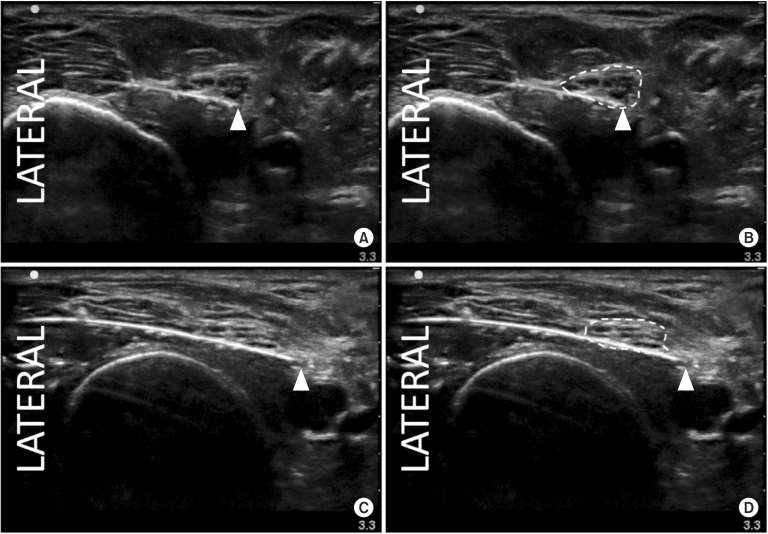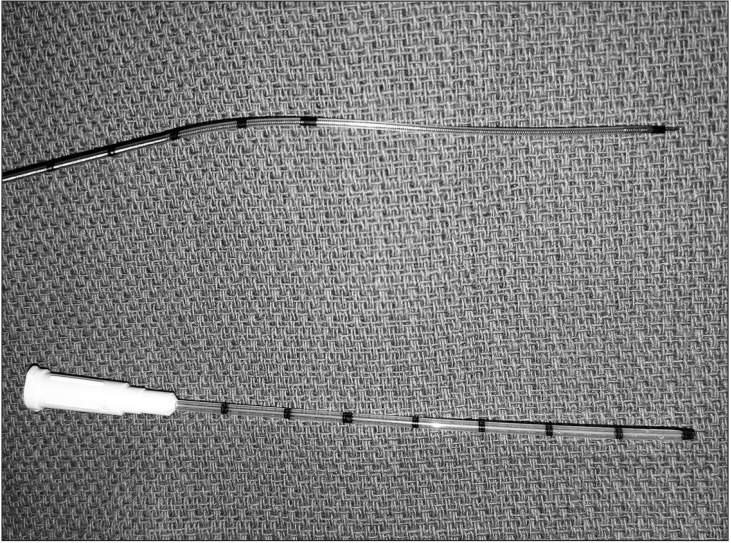1. Chelly JE, Ghisi D, Fanelli A. Continuous peripheral nerve blocks in acute pain management. Br J Anaesth. 2010; 105(Suppl 1):i86–i96. PMID:
21148658.

2. Richman JM, Liu SS, Courpas G, Wong R, Rowlingson AJ, McGready J, et al. Does continuous peripheral nerve block provide superior pain control to opioids? A meta-analysis. Anesth Analg. 2006; 102:248–257. PMID:
16368838.

3. Marhofer D, Marhofer P, Triffterer L, Leonhardt M, Weber M, Zeitlinger M. Dislocation rates of perineural catheters: a volunteer study. Br J Anaesth. 2013; 111:800–806. PMID:
23748198.

4. Ip VH, Rockley MC, Tsui BC. The catheter-over-needle assembly offers greater stability and less leakage compared with the traditional counterpart in continuous interscalene nerve blocks: a randomized patient-blinded study. Can J Anaesth. 2013; 60:1272–1273. PMID:
24043379.

5. Tsui BC, Ip VH. Catheter-over-needle method reduces risk of perineural catheter dislocation. Br J Anaesth. 2014; 112:759–760. PMID:
24645151.

6. Tsui BC, Tsui J. Less leakage and dislodgement with a catheter-over-needle versus a catheter-through-needle approach for peripheral nerve block: an ex vivo study. Can J Anaesth. 2012; 59:655–661. PMID:
22565332.

7. Ilfeld BM, Fredrickson MJ, Mariano ER. Ultrasound-guided perineural catheter insertion: three approaches but few illuminating data. Reg Anesth Pain Med. 2010; 35:123–126. PMID:
20216031.
8. Leng JC, Harrison TK, Miller B, Howard SK, Conroy M, Udani A, et al. A pilot study to assess adductor canal catheter tip migration in a cadaver model. J Anesth. 2015; 29:308–312. PMID:
25288506.

9. Mariano ER, Cheng GS, Choy LP, Loland VJ, Bellars RH, Sandhu NS, et al. Electrical stimulation versus ultrasound guidance for popliteal-sciatic perineural catheter insertion: a randomized controlled trial. Reg Anesth Pain Med. 2009; 34:480–485. PMID:
19920423.
10. Andersen HL, Andersen SL, Tranum-Jensen J. Injection inside the paraneural sheath of the sciatic nerve: direct comparison among ultrasound imaging, macroscopic anatomy, and histologic analysis. Reg Anesth Pain Med. 2012; 37:410–414. PMID:
22609646.
11. Capdevila X, Dadure C, Bringuier S, Bernard N, Biboulet P, Gaertner E, et al. Effect of patient-controlled perineural analgesia on rehabilitation and pain after ambulatory orthopedic surgery: a multicenter randomized trial. Anesthesiology. 2006; 105:566–573. PMID:
16931991.
12. Ilfeld BM, Morey TE, Wang RD, Enneking FK. Continuous popliteal sciatic nerve block for postoperative pain control at home: a randomized, double-blinded, placebo-controlled study. Anesthesiology. 2002; 97:959–965. PMID:
12357165.
13. Ilfeld BM, Enneking FK. Continuous peripheral nerve blocks at home: a review. Anesth Analg. 2005; 100:1822–1833. PMID:
15920221.

14. Ahsan ZS, Carvalho B, Yao J. Incidence of failure of continuous peripheral nerve catheters for postoperative analgesia in upper extremity surgery. J Hand Surg Am. 2014; 39:324–329. PMID:
24480691.
15. Ilfeld BM, Esener DE, Morey TE, Enneking FK. Ambulatory perineural infusion: the patients' perspective. Reg Anesth Pain Med. 2003; 28:418–423. PMID:
14556132.

16. Klein SM, Nielsen KC, Buckenmaier CC 3rd, Kamal AS, Rubin Y, Steele SM. 2-octyl cyanoacrylate glue for the fixation of continuous peripheral nerve catheters. Anesthesiology. 2003; 98:590–591. PMID:
12552227.

17. Boezaart AP. Continuous interscalene block for ambulatory shoulder surgery. Best Pract Res Clin Anaesthesiol. 2002; 16:295–310. PMID:
12491559.

18. Ilfeld BM. Continuous peripheral nerve blocks in the hospital and at home. Anesthesiol Clin. 2011; 29:193–211. PMID:
21620338.

19. Mariano ER, Loland VJ, Bellars RH, Sandhu NS, Bishop ML, Abrams RA, et al. Ultrasound guidance versus electrical stimulation for infraclavicular brachial plexus perineural catheter insertion. J Ultrasound Med. 2009; 28:1211–1218. PMID:
19710219.

20. Mariano ER, Loland VJ, Sandhu NS, Bishop ML, Meunier MJ, Afra R, et al. A trainee-based randomized comparison of stimulating interscalene perineural catheters with a new technique using ultrasound guidance alone. J Ultrasound Med. 2010; 29:329–336. PMID:
20194929.

21. Kim TE, Howard SK, Funck N, Harrison TK, Walters TL, Wagner MJ, et al. A randomized comparison of long-axis and short-axis imaging for in-plane ultrasound-guided popliteal-sciatic perineural catheter insertion. J Anesth. 2014; 28:854–860. PMID:
24789659.

22. Mariano ER, Kim TE, Funck N, Walters T, Wagner MJ, Harrison TK, et al. A randomized comparison of long-and short-axis imaging for in-plane ultrasound-guided femoral perineural catheter insertion. J Ultrasound Med. 2013; 32:149–156. PMID:
23269720.

23. Yu B, Hu X, Zou T, He M, Cai G. Effects of postoperative continuous femoral nerve block analgesia with braun continuous peripheral nerve block catheter set versus novel needle-over-cannula after total knee arthroplasty. Med Sci Monit. 2015; 21:1843–1849. PMID:
26111971.

24. Herring AA, Liu B, Kiefer MV, Nagdev AD, Tsui BC. ED placement of perineural catheters for femoral fracture pain management. Am J Emerg Med. 2014; 32:287.e1–287.e3.

25. Ip V, Tsui B. The safety of an interscalene catheter-over-needle technique. Anaesthesia. 2013; 68:774–775. PMID:
24044390.

26. Symons B, Wuest S, Leonard T, Herzog W. Biomechanical characterization of cervical spinal manipulation in living subjects and cadavers. J Electromyogr Kinesiol. 2012; 22:747–751. PMID:
22402264.

27. Webb CA, Kim TE, Funck N, Howard SK, Harrison TK, Ganaway T, et al. Comparison of catheter tip migration using flexible and stimulating catheters inserted into the adductor canal in a cadaver model. J Anesth. 2015; 29:471–474. PMID:
25510467.






 PDF
PDF Citation
Citation Print
Print




 XML Download
XML Download